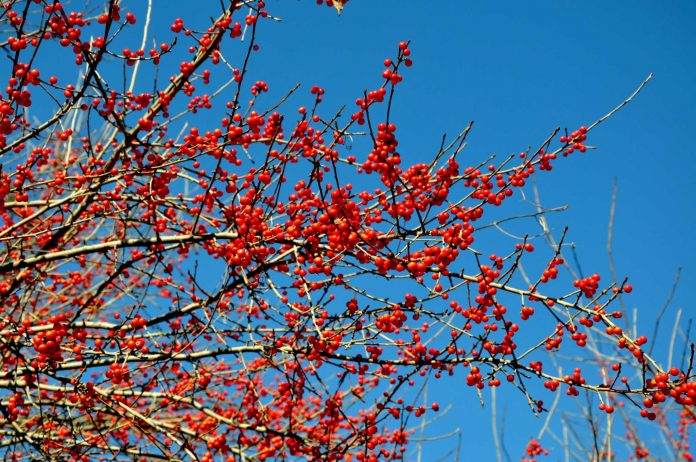-

The possum haw is related to the winterberry but is larger and even showier in its winter display of fruit. Deft pruning will keep it looking garden-worthy.
The possum haw is related to the winterberry but is larger and even showier in its winter display of fruit. Deft pruning will keep it looking garden-worthy.
Photo: Tony Dove, “Essential Native Trees And Shrubs For The Eastern United States”
The possum haw is related to the winterberry but is larger and even showier in its winter display of fruit. Deft pruning will keep it looking garden-worthy.
The possum haw is related to the winterberry but is larger and even showier in its winter display of fruit. Deft pruning will keep it looking garden-worthy.
Photo: Tony Dove, “Essential Native Trees And Shrubs For The Eastern United States”
Extreme weather associated with climate change appears to be arriving on cue, and the gardener cannot see out the year in these parts without reflecting on the Year of the Monsoon.
Next year, by the way, will be the Year of the Big Chill, followed by the Year of the Great Drought, followed by the Year of the Steaming Cauldron. You heard it here first.
But back to 2018, which brought not just a whole lotta H2O but also bizarre growing conditions. Plants thirst for rain, and a lot of precipitation can produce a pleasantly lush landscape, but many plants cannot abide constantly saturated soil. This was not a good year to have yews, aucubas, roses, figs, pines or herbs in beds that would not dry out. What are the lessons?
Waterlogged sites are often associated with compacted clay soils, and addressing this vexing condition takes three approaches. You can put in a drain – complicated, expensive and, if you do it yourself, backbreaking. The last perforated pipe I laid became home to a smug chipmunk. I felt so – taken advantage of.
Another option is to create raised beds above the swamp. This avenue also requires hauling a lot of material and follow-up appointments with the chiropractor, acupuncturist or massage therapist, or all three. Often the superimposed growing beds look like nasty roadside berms that no amount of vegetation can hide.
The third option is the most sensible: that is, to remove plants that are unhappy or dead and replace them with others that can handle dense, poor soil and periods of inundation. Such conditions, by the way, are one of the common reasons lawns grow thin and weedy, and you may want to replace areas of turf with plant beds. Winter, far from being a dormant season, is tailor-made for such pondering and planning.
You have to limit your choices when planting in wet ground, and in the past, the palette has tended toward one-season wonders such as red twig dogwoods and shrub willows. But the broad contemporary interest in native plants has opened the possibilities. You will find some great suggestions in a new book by Tony Dove and Ginger Woolridge, “Essential Native Trees and Shrubs for the Eastern United States.”
I keep waiting for the serviceberry to become a more popular garden addition; it’s a beautiful, large, multi-stem shrub with white blossoms in spring, red-purple summer fruit and brilliant orange fall color. If you have ill-draining soil, and perhaps a little shade, this is your answer. There are three or four different plants available in the nursery trade, including the big-boned Amelanchier arborea and A. canadensis. Most smaller gardens are better served by the Allegheny serviceberry, A. laevis, which grows to a big clump about 15 feet high and as much across, though the width can be reduced by the gardener.
The Chinese fringe tree, I once discovered to my surprise, grows large and dense. But the native version (Chionanthus virginicus) does not, becoming a small, low-branched tree or large shrub typically 12 to 15 feet high and as wide at maturity, and covered in showy, fleecy white blossoms in the spring. As with many of these woody plants, it grows either as a multi-stemmed shrub or a low-branched tree; you have to peruse the nursery aisles to get the plant you want.
Many people know the deciduous winterberry holly, which would work well in a poorly drained location, but its cousin, the possum haw, should also be at the top of the list. Its botanic name is Ilex decidua. It is bigger and a little wilder than winterberry, and could become something of a suckering mess with age and neglect. But in the hands of a loving gardener who will keep it shaped, it can have stunning presence – especially in winter in red fruit. As with other hollies, you will need a male version for fruiting.
Dove and Woolridge’s book introduced me to another large shrub, the titi (tee-tee) or swamp cyrilla. It is large and loose, a little leggy judging by the photos, but attractive and different. The slender leaves turn orange in fall, and not all of them may drop in a mild winter. It is native to low-lying coastal areas of the Southeast. When it’s happy, it forms spreading colonies. By late spring, it is loaded with pendulous and fragrant white flowers.
The Alabama croton (Croton alabamensis) is a novelty, six-foot-high filler shrub for the relaxed shade garden, with silver undersides to the green leaves. The silver contrasts dramatically with the orange fall color, the yellow flower clusters of late winter are more interesting than pretty, and the leaves emit an apple fragrance when crushed. “It’s a really cool-looking shrub,” Dove told me.
I had forgotten about an evergreen named Morella cerifera, which was named Myrica when I last greeted it, but its common name has remained. Southern wax myrtle hails from coastal New Jersey to Texas and is a handsome garden plant, and many dwarf varieties have been developed.
The regular version grows quickly, as much as three feet a year (at least that in this year), and takes nicely to pruning, even shearing. This would make it a wonderful screening hedge – the leaves are dense but narrow and light green – for a gardener who likes order and a well-oiled pruner.
If you can’t find these plants at your local garden center, native plant nurseries should have them, and many come together in the spring for collective plant sales. Local and state native plant societies list such sales in advance.
If you do plant any of these beauties, keep them watered during periods of dryness, especially in their first two years as the roots get established. But first we must gird ourselves for winter, which I hope against recent odds will give us days that are constantly cool so plants may sleep. At least the days are getting reliably longer. That hasn’t changed. Has it?
Gardening tip
Poinsettias thrive in bright environments away from heat and drafts. Feel moisture levels with your finger – the soil should be allowed to dry a little between waterings. Remove decorative sleeves to allow water to drain through the pot.





































